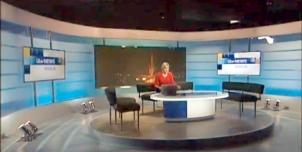Full Freeview on the Sudbury (Suffolk, England) transmitter
| Google Streetview | Google map | Bing map | Google Earth | 52.005,0.786 or 52°0'17"N 0°47'8"E | CO10 5NG |
The symbol shows the location of the Sudbury (Suffolk, England) transmitter which serves 440,000 homes. The bright green areas shown where the signal from this transmitter is strong, dark green areas are poorer signals. Those parts shown in yellow may have interference on the same frequency from other masts.
_______
Digital television services are broadcast on a multiplexes (or Mux) where many stations occupy a single broadcast frequency, as shown below.
64QAM 8K 3/4 27.1Mb/s DVB-T MPEG2
H/V: aerial position (horizontal or vertical)
The Sudbury (Suffolk, England) mast is a public service broadcasting (PSB) transmitter, it does not provide these commercial (COM) channels: .
If you want to watch these channels, your aerial must point to one of the 80 Full service Freeview transmitters. For more information see the will there ever be more services on the Freeview Light transmitters? page.
Which Freeview channels does the Sudbury transmitter broadcast?
If you have any kind of Freeview fault, follow this Freeview reset procedure first.Digital television services are broadcast on a multiplexes (or Mux) where many stations occupy a single broadcast frequency, as shown below.
64QAM 8K 3/4 27.1Mb/s DVB-T MPEG2
H/V: aerial position (horizontal or vertical)
The Sudbury (Suffolk, England) mast is a public service broadcasting (PSB) transmitter, it does not provide these commercial (COM) channels: .
If you want to watch these channels, your aerial must point to one of the 80 Full service Freeview transmitters. For more information see the will there ever be more services on the Freeview Light transmitters? page.
Which BBC and ITV regional news can I watch from the Sudbury transmitter?

BBC Look East (East) 0.8m homes 3.2%
from Norwich NR2 1BH, 77km north-northeast (24°)
to BBC East region - 27 masts.
70% of BBC East (East) and BBC East (West) is shared output

ITV Anglia News 0.8m homes 3.2%
from NORWICH NR1 3JG, 78km north-northeast (24°)
to ITV Anglia (East) region - 26 masts.
All of lunch, weekend and 80% evening news is shared with Anglia (West)
Are there any self-help relays?
| Felixstowe West | Transposer | 1000 homes +1000 or more homes due to expansion of affected area? | |
| Witham | Transposer | 14 km NE Chelmsford. | 118 homes |
How will the Sudbury (Suffolk, England) transmission frequencies change over time?
| 1984-97 | 1997-98 | 1998-2011 | 2011-13 | 1 Aug 2018 | |||||
| B E T | B E T | B E T | E T | K T | |||||
| C29 | SDN | ||||||||
| C31 | ArqA | ||||||||
| C35 | C5waves | C5waves | |||||||
| C37 | ArqB | ||||||||
| C41 | ITVwaves | ITVwaves | ITVwaves | D3+4 | D3+4 | ||||
| C44 | BBC2waves | BBC2waves | BBC2waves | BBCA | BBCA | ||||
| C47 | C4waves | C4waves | C4waves | BBCB | BBCB | ||||
| C51tv_off | BBC1waves | BBC1waves | BBC1waves | ||||||
| C56tv_off | ArqB | ||||||||
| C58tv_off | SDN | ||||||||
| C60tv_off | -ArqA |
tv_off Being removed from Freeview (for 5G use) after November 2020 / June 2022 - more
Table shows multiplexes names see this article;
green background for transmission frequencies
Notes: + and - denote 166kHz offset; aerial group are shown as A B C/D E K W T
waves denotes analogue; digital switchover was 6 Jul 11 and 20 Jul 11.
How do the old analogue and currrent digital signal levels compare?
| Analogue 1-4 | 250kW | |
| SDN, ARQA, ARQB, BBCA, D3+4, BBCB | (-4dB) 100kW | |
| Analogue 5 | (-7dB) 50kW | |
| Mux 2* | (-14.9dB) 8.1kW | |
| Mux B* | (-15.2dB) 7.5kW | |
| Mux 1* | (-15.5dB) 7kW | |
| Mux A* | (-17dB) 5kW | |
| Mux C* | (-22.2dB) 1.5kW | |
| Mux D* | (-23.6dB) 1.1kW |
Which companies have run the Channel 3 services in the Sudbury transmitter area
|
|
Friday, 29 June 2012
Dale
8:27 PM
Ipswich
8:27 PM
Ipswich
Russell Battle : ArqA is now on high power BUT has moved up the 'dial' to Channel 60 (from 54). If you have an 'old' Group-B aerial (which only officially goes to CH53), that would explain why it is struggling to pull in CH60. Are you now getting ArqB on Ch56 OK? (was on low-power on CH63 until 27th)
| link to this comment |
Dale's: mapD's Freeview map terrainD's terrain plot wavesD's frequency data D's Freeview Detailed Coverage
Dale
8:32 PM
Ipswich
8:32 PM
Ipswich
Mrs Baker : see my answer to Russell Battle. 5* is now part of SDN which is being broadcast on Channel 58 (up from 49) so if you, too, have an old aerial you could be struggling to get that and ArqA on CH60.
| link to this comment |
Dale's: mapD's Freeview map terrainD's terrain plot wavesD's frequency data D's Freeview Detailed Coverage
B
Ben8:59 PM
Clacton-on-sea
Still no Dave, ITV4, etc. Retuned and no joy. Fault on the Sudbury transmitter? All working well since Wednesday then suddenly loads of stations disappeared tonight.
| link to this comment |
Ben's: mapB's Freeview map terrainB's terrain plot wavesB's frequency data B's Freeview Detailed Coverage
S
Steve10:01 PM
Witham
It's nice to be back with ITV 4/Film 4 etc since the 27th update to Sudbury transmissions. However I've now lost E4+1, Dave, Sky news and Talksport radio etc from Arq A now broadcasting on channel -60. This is very odd as channel 58 is coming through nice and strong, pretty much full strength. Yesterday when I was re-tuning I picked up channel -60 albeit at a mediocre strentgh of around 67%, it's now has no signal quality and about 15% strength!! What goes??
| link to this comment |
Steve's: mapS's Freeview map terrainS's terrain plot wavesS's frequency data S's Freeview Detailed Coverage
M
Mark Fletcher11:19 PM
Lytham St. Annes
Steve,Witham.The most likely cause is atmospheric conditions or to rephrase the inversion effect !
Or are you still using a group B (yellow tipped) aerial ?
If you are then you may have to replace your old antenna with a new group E (brown tipped) semi-wideband aerial,with new copper-copper black coloured co-ax cable and new preferably brass co-ax aerial plug !
| link to this comment |
Mark's: mapM's Freeview map terrainM's terrain plot wavesM's frequency data M's Freeview Detailed Coverage
M
Mark Fletcher11:41 PM
Lytham St. Annes
Ben,Clacton on Sea.
I have just checked and from what i am aware there are no problems reported at Sudbury main transmitter whatsoever !
Are you still using an old group B aerial,which could explain why you are unable to pick up ArqA on frequency 60 at Sudbury ?
And you stated that in your earlier post you lost everything on Channel 30 at 8pm tonight,well Sudbury does not use frequency 30,but Crystal Palace transmitter does use BBCB (HD) on frequency 30 itself.Are your aerials diplexed as such,a group A aerial horizontally polarised aimed at Crystal Palace,and most likely an old group B aerial horizontally polarised aimed at Sudbury ?
Then again the inversion effect is another possibility as South East England experienced settled weather just recently.
| link to this comment |
Mark's: mapM's Freeview map terrainM's terrain plot wavesM's frequency data M's Freeview Detailed Coverage
Saturday, 30 June 2012
B
Ben1:33 AM
Clacton-on-sea
Thanks for your reply, Mark. The channel 30 thing was a red herring, sorry, my mistake. Ok, so what's happening is I lost a load of stations last week, then on Wednesday when the Sudbury transmitter was pimped up, they all came back with good picture quality, no issues, happy days. Then tonight I'm watching Dave with a perfect picture and suddenly it falls over and I've lost a whole lot of other stations. All the BBC stations and a few others (on 41 and 44) are fine with a signal quality of 8/10 but a signal strength of 4/10. I keep getting a "new dvb channel has been found" message but when I re-scan no new ones are found. I am at sea level, so get a few glitches sometimes but not experienced a complete outage like this before. Neighbours are getting intermittent problems too. It's as if the transmitter has gone back to its former low power? Anyway, appreciate your thoughts on this... cheers.
| link to this comment |
Ben's: mapB's Freeview map terrainB's terrain plot wavesB's frequency data B's Freeview Detailed Coverage
T
Trevor Wright9:05 AM
Braintree, Essex:
Last night, 29 June, from around 18:00 onwards for an hour or more I was getting drop-outs and NO SIGNAL on various stations when viewed via my TVonics MDR 240 set-top box, which was however showing reasonable signal strength but it was fluctuating a bit.
Switching to the same channel on my Humax PVR - no problems at all, and its signal strength was showing slight fluctuations but consistent 100% quality. I have a recently fitted broadband aerial, 21-39 channel Antiference filter and modern style of downcable. I guess the receiver on the Humax is more tolerant than the TVonics. After about 20:00 no further problems, good picture with no disturbances on either source.
Atmospheric effects? or did Sudbury have a wobble?
Also, why has channel 47 shown a higher signal strength before and after 27 June (about 73-76% on my Humax PVRs meter) than the other channels which are now 70-72% whereas before 41 and 44 were 73%?
| link to this comment |
G
Graham Peters9:28 AM
No reported problems at Sudbury, but CH58 (Mux A) had problems last night and now no signal at all this morning.
Looking forward to a day of Morse on ITV3, while ducking in from the garden to avoid the rain.
| link to this comment |
I have also lost channel 60 here in Clacton to.
I can get it though if I point the aerial in the other direction but then London comes in really strong.
I have given up with Sudbury and now using CP.
Channels 58 and 60 are only 40% signal but all the stuff on CP is over 65%
| link to this comment |
Select more comments
Your comment please!




